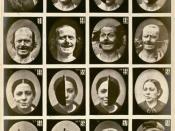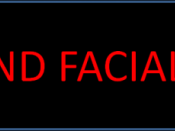"LATERAL ASYMMETRY IN INTENSITY OF EMOTIONAL EXPRESSION"
People have always been puzzled by the functionality of the human brain. However, it was only over a century ago, that after the discoveries of French surgeon Broca (1860) -examining brain damage patients- that this fascination was transformed into further empiricism. From such research scientists were able to conclude that the cerebrum is made up of two cerebral hemispheres, which despite appearing symmetrical, on closer scrutiny reveal asymmetries. Thus, to examine these asymmetries, various areas were studied, and one of these areas was facial expressions and emotions, because as Sackeim & Gur (1978) suggested "the left and right sides of the face are physiognomically asymmetrical." These studies also sought to comprehend facial expressions and emotions beyond the taboos and universal trivialities of society.
Firstly, research of the brain revealed that the nervous system appeared to be almost split into two halves with a crossing over effect-taking place, connecting the two hemispheres, to various nerves.
These nerve fibers (corpus callosum) in turn proceeded to process the relevant brain information (occurring interchangeably between the hemispheres), resulting in the functioning of different components. However, an inverse relationship existed between the hemisphere processing the information and the component that fulfilled it. The crossing over of nerves from the different hemisphere going to the opposite sides of the face became known as contralateral. For example, the right hemisphere controlled the left hand, and vice versa. This relationship was evident in all of the cortical areas (primary motor area, primary somatosensory, primary visual area, primary auditory area, and association areas).
New observations in brain damage victims, reinforced Broca's earlier claim's that the two hemispheres had different specializations. The left hemisphere -the so-called dominant hemisphere- appeared to be predominantly verbal and analytical, skilled in linguistic description, logical analysis and...


